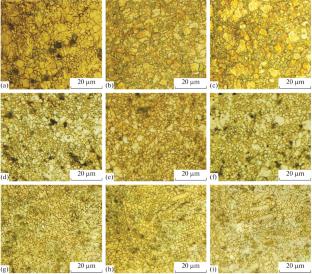稀土元素对T5处理后ZK60合金组织和力学性能的影响
摘要
研究了ZK60挤压合金加入3 wt后的显微组织和力学性能 % of Ce and Y and T5 operation. The microstructure of the base alloy consists of α‑Mg and Mg7Zn3. In addition to these phases, MgZn2Ce and Mg3Y2Zn3 phases are formed by adding Ce and Y, respectively. The addition of rare earth elements reduces the grain size of the base alloy from 6.1 μm to less than 3 μm. The volume fraction of precipitates also increases because of the additions. After T5 operation for different times, it was observed that the hardness peak (88 HV) for the base alloy is achieved after 18 hours. However, the peak hardness of alloys containing rare earth elements occurred in 24 hours. Increasing the aging time results in an increase in the grain size of the base alloy, while it led to a slight increase in the grain size of alloys containing rare earth elements. The higher hardness at the peak age of all studied alloys is explained based on the increase in the volume fraction of precipitates during this operation. The delay in the peak age in alloys containing rare earth elements is due to the delay in the formation of \(\beta _{2}^{'}\) precipitates. The shear punch test results of extruded alloys show that in alloys containing Ce and Y the shear strength is 156 and 160 MPa, respectively. While this value is about 148 MPa for the base alloy. At the peak age, this strength for ZK60-Ce and ZK60-Y alloys increases by 11% and 13%, respectively. Higher strength and hardness in Y‑containing alloys are due to the simultaneous strengthening of solid solution and precipitates along with the formation of precipitates with high thermal stability.

In this study, the microstructure and mechanical properties of ZK60 extruded alloy were investigated after adding 3 wt % of Ce and Y and T5 operation. The microstructure of the base alloy consists of α‑Mg and Mg7Zn3. In addition to these phases, MgZn2Ce and Mg3Y2Zn3 phases are formed by adding Ce and Y, respectively. The addition of rare earth elements reduces the grain size of the base alloy from 6.1 μm to less than 3 μm. The volume fraction of precipitates also increases because of the additions. After T5 operation for different times, it was observed that the hardness peak (88 HV) for the base alloy is achieved after 18 hours. However, the peak hardness of alloys containing rare earth elements occurred in 24 hours. Increasing the aging time results in an increase in the grain size of the base alloy, while it led to a slight increase in the grain size of alloys containing rare earth elements. The higher hardness at the peak age of all studied alloys is explained based on the increase in the volume fraction of precipitates during this operation. The delay in the peak age in alloys containing rare earth elements is due to the delay in the formation of \(\beta _{2}^{'}\) precipitates. The shear punch test results of extruded alloys show that in alloys containing Ce and Y the shear strength is 156 and 160 MPa, respectively. While this value is about 148 MPa for the base alloy. At the peak age, this strength for ZK60-Ce and ZK60-Y alloys increases by 11% and 13%, respectively. Higher strength and hardness in Y‑containing alloys are due to the simultaneous strengthening of solid solution and precipitates along with the formation of precipitates with high thermal stability.

 求助内容:
求助内容: 应助结果提醒方式:
应助结果提醒方式:


